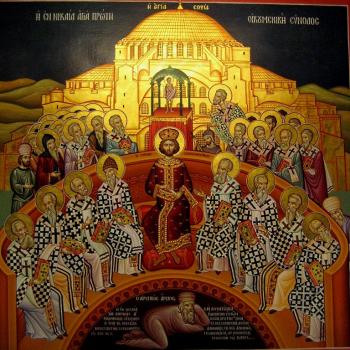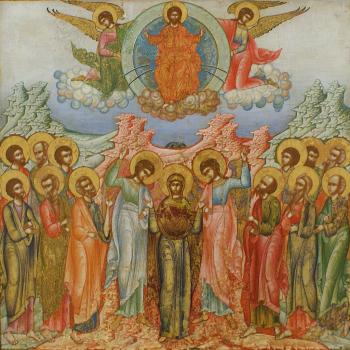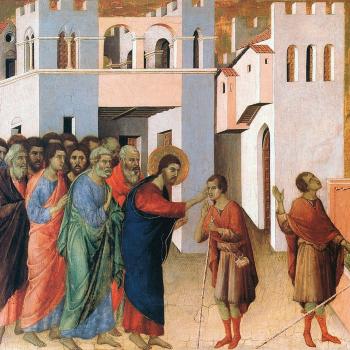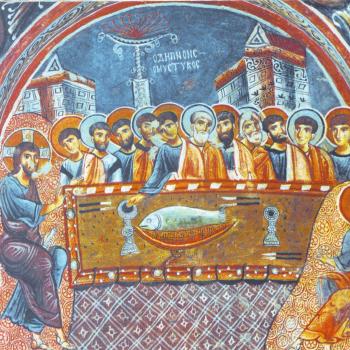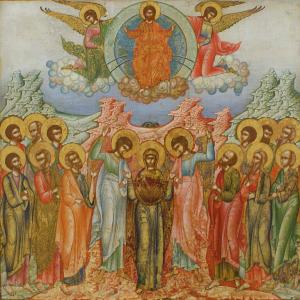
Scripture has two major representations of the ascension;[1] the first is a very short description of what happened:
Then he led them out as far as Bethany, and lifting up his hands he blessed them. While he blessed them, he parted from them, and was carried up into heaven. And they returned to Jerusalem with great joy, worshipped him, and were continually in the temple blessing God (Lk 24:50-53 RSV).
The other presentation of the ascension fleshes out the event. It provides us the context, among which, the way Jesus’ disciples still misunderstood the resurrection, as they thought Jesus was going to fulfill their messianic dreams. The ascension circumvented those expectations by showing us that Jesus had to and would accomplish something else, something far greater; his kingdom was truly not limited to this world but rather, transcended it:
So when they had come together, they asked him, “Lord, will you at this time restore the kingdom to Israel?” He said to them, “It is not for you to know times or seasons which the Father has fixed by his own authority. But you shall receive power when the Holy Spirit has come upon you; and you shall be my witnesses in Jerusalem and in all Judea and Samaria and to the end of the earth.” And when he had said this, as they were looking on, he was lifted up, and a cloud took him out of their sight. And while they were gazing into heaven as he went, behold, two men stood by them in white robes, and said, “Men of Galilee, why do you stand looking into heaven? This Jesus, who was taken up from you into heaven, will come in the same way as you saw him go into heaven” (Acts 1:6-11 RSV).
Having shown that death itself could not hold him back, Jesus’ disciples thought that there would be nothing left which could get in his way of being the messianic-king. They expected he would finally reveal himself as the true, eschatological king of Israel and establish his messianic kingdom. This is why they asked if Jesus was going to restore the kingdom of Israel. Not only did they believe that it was time for Israel to be set free from Rome, they thought it was time for Israel to take central stage in the world, taking the place Rome had and making it its own. Their hopes and dreams were still far too limited. They were right to view Israel was significant, but the restoration of Israel was not meant to have it merely replace Rome and then do to the rest of the world what Rome had done to them. What was to be restored was the relationship the world has with God, and the people of the world with each other.
The time had come…. and it had not yet fully come. For Jesus was going to continue his messianic work, and that meant, he was going to help the world find its proper place in the eternal kingdom of God. The eschaton was immanent and not yet. The restoration of Israel is connected with the restoration of all things in the eschaton, and the eschaton, though it is immanent thanks to the incarnation, also transcends time and space. The restoration of Israel was accomplished, is being accomplished, and will always be accomplished with the restoration of all things in the eternal activity of God, an act which includes and is intricately linked to Jesus’ death, resurrection and ascension into heaven. The culmination of the work of the eschaton in time is the end of time itself. Once time has come to an end, all that remains will be eternity. When that will happen, we do not know. Nonetheless, the immanence of the eschaton in time points to the fact that though the end of time has not come, elements of the end are interacting with us at every point of time; it is as if the eschaton is bleeding through the veil which separates time from eternity, helping to shape and direct what happens in time (including many things which could only be said to be miraculous). And the ascension is a representation of this, where Jesus shows the connection which he established between heaven and earth, between eternity and the temporal realm of existence.
Now, it is easy to misconstrue the ascension as an event in which Jesus went up into the heavens, that is, into space. Indeed, many throughout history understood it in such a fashion. Others, however, saw the problem which lay behind such an interpretation. It confuses materiality with the spiritual realm. If the heaven which is promised us, the heaven in which we find ourselves with God, is merely a locality in space and time, God would likewise be rendered a material being. Thus others understood that the ascension was not merely a change in Jesus’ location, but a change in his modality of being. The “heaven” which Jesus “ascended” was eternity, a state of being which transcends time (and so, also, transcends spatial locality). Jesus took with him his transfigured body, showing that what is material can be transfigured with grace, that is, it can be spiritualized, and so exist in a modality which is not merely material in nature. The new heaven and the new earth of eternity is the transformed version of the old heaven and earth, and not some new creation made ex nihilo.
The ascension of Christ, therefore, must not be understood simply as Jesus rising up into the sky and going out into space. That mistake has led many to become confused when humanity made its way out into space and did not find Jesus (or others who had been assumed into heaven) waiting for them. Though it is understandable why many could and did read the text in this manner, and so we must not discount that it has influenced tradition, those who understood the spiritualization of the flesh which happened at the resurrection understood that this would be too limited a scope for our understanding of the ascension. God transcends all of space and time. To suggest Jesus only went to new location in space-time is to ignore the true implication of the ascension, which is to show us that Jesus, in his transfigured body, has a place in eternity “at the right hand of the Father,” and we, united with Jesus, can likewise have a place with him there, sharing in and partaking of the divine glory.
[1] There are various texts, such as Psalm 24, which can be and are interpreted as discussions of the ascension. While such interpretations are valid from the Christian perspective, they are not the only potential ways to read those texts. It is important to remember that Scripture can and is often understood in a variety of ways, and we are not expected to hold only one interpretation is valid. Thus, reading the texts in relation to the ascension should not stop us from finding other meanings which can be and have been had from them.
Stay in touch! Like A Little Bit of Nothing on Facebook.
If you liked what you read, please consider sharing it with your friends and family!




